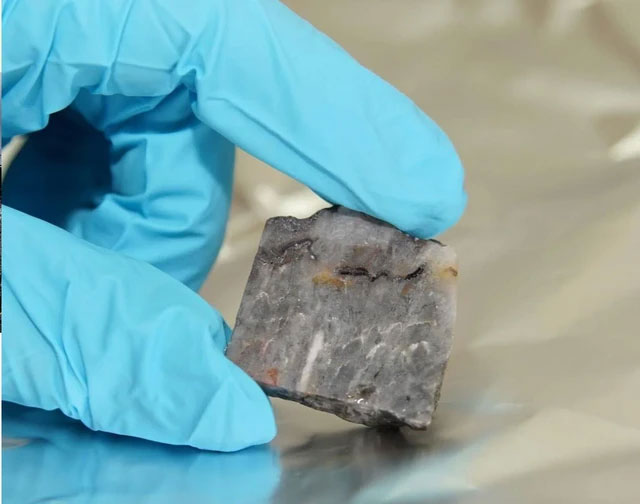Discovering the shocking remains of a 3.5 billion-year-old creature
The mysterious world 3.5 billion years ago with the most primitive living creatures on the planet on a lost supercontinent has just been "revealed".
A new study just published in the journal Precambrian Research has found remains of biomass 3.5 billion years ago from the Dresser Formation in Western Australia , helping humanity understand more about the earliest organisms on earth. .

An ancient stone tablet contains traces of 3.5 billion-year-old creatures - (Photo: University of Göttingen (Germany)).
According to Heritage Daily, it is an area of the Pillbara craton in Western Australia, a continental crust that existed from the Archaean 3.8-2.7 billion years ago.
These ancient rocks may belong to the supercontinent Vaalbara or the continent Ur, which has long disappeared after many times the continents on the planet merged and then separated from each other.
A research team from the University of Göttingen (Germany) analyzed barium sulfate - i.e. barite rock - from the Dresser Formation, thereby identifying microscopic particles in the rock sample as traces of living organisms.
These particles were likely deposited as sediments in the ancient mid-crater waters, while some particles were transported and transformed by hydrothermal waters in the volcanically active area.
By analyzing carbon isotopes, the researchers demonstrated a world of different types of microorganisms that lived in the vicinity of this volcano.
It was a world similar to today's ecosystems in Iceland's sizzling geysers or the hot springs in America's Yellowstone National Park.
This discovery once again shows that warm underground water flows, carrying many minerals from the ground, are where early life resides, from the bottom of the sea to ancient continents.
Besides, this abundance of biomass 3.5 billion years ago also shows that life had begun on Earth for a while and was quite diverse by a few hundred million years after the beginning of the Paleontological Era . Thai Co .
According to previous studies, life on Earth may have started about 4.1-3.8 million years ago, which is the end of the previous Fire Era or right at the intersection of Fire City - Tai Ancient.
- Shocking the 'bird' remains in 5,000 year old tombs
- Discovering a 2,000-year-old remains in a shipwreck in the Mediterranean
- 7 million-year-old human remains bring evolutionary breakthrough, can rewrite history
- 10,000-year-old remains in an underwater cave
- Unearth the remains of Prime Minister Luu Gu, an expert in discovering the shocking truth: Movies have long turned out to have deceived the audience!
- 97 5,000-year-old remains were deformed in a house of 20 square meters
- Four thousand-year-old remains buried with a yellow hat
- Mysterious remains of women belong to another human species
- 9,000-year-old remains reveal the collapse of the old city
- Discover the remains of women bent over 4,000 years in the grave
- Opening the 1,000-year-old coffin, containing the missionary remains from the 11th century
- Secrets of the 7,000-year-old 'shaman' female remains
 Discovered an ancient centipede fossil 99 million years old
Discovered an ancient centipede fossil 99 million years old Discovered bat-like dinosaurs in China
Discovered bat-like dinosaurs in China Discovered a 200-year-old bronze cannon of the coast
Discovered a 200-year-old bronze cannon of the coast Discover 305 million-year-old spider fossils
Discover 305 million-year-old spider fossils